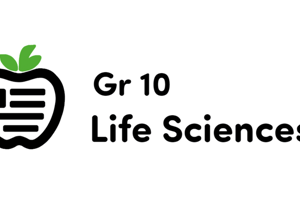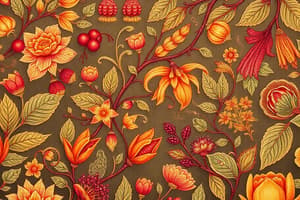Podcast
Questions and Answers
Which organic compound is correctly matched with the subunit that composes it?
Which organic compound is correctly matched with the subunit that composes it?
- Protein - Fatty Acid
- Starch - Glucose (correct)
- Lipid - Sucrose
- Maltose - Amino Acid
Glucose and maltose are classified as organic compounds because they both are carbon-containing substances.
Glucose and maltose are classified as organic compounds because they both are carbon-containing substances.
True (A)
Which is an organic compound found in most cells?
Which is an organic compound found in most cells?
Glucose
What is the ratio of hydrogen to oxygen atoms in a molecule of glucose?
What is the ratio of hydrogen to oxygen atoms in a molecule of glucose?
A specific organic compound contains only the elements carbon, hydrogen, and oxygen in the ratio of 1:2:1. This compound is probably a _____
A specific organic compound contains only the elements carbon, hydrogen, and oxygen in the ratio of 1:2:1. This compound is probably a _____
What are the end products of a carbohydrate hydrolysis reaction?
What are the end products of a carbohydrate hydrolysis reaction?
What is the chemical formula for a carbohydrate molecule?
What is the chemical formula for a carbohydrate molecule?
The linking together of many molecules of glucose may produce a molecule of _____
The linking together of many molecules of glucose may produce a molecule of _____
Plants store carbohydrates in the form of _____
Plants store carbohydrates in the form of _____
Cellulose is formed from glucose molecules by a process known as _____
Cellulose is formed from glucose molecules by a process known as _____
In living organisms, lipids function mainly as _____
In living organisms, lipids function mainly as _____
In addition to carbon and hydrogen, a molecule of vegetable oil contains _____
In addition to carbon and hydrogen, a molecule of vegetable oil contains _____
Molecules consisting only of carbon, hydrogen, and oxygen atoms make up a large part of a plant cell wall. These molecules are classified as _____
Molecules consisting only of carbon, hydrogen, and oxygen atoms make up a large part of a plant cell wall. These molecules are classified as _____
Carbohydrates are primary _________ _________
Carbohydrates are primary _________ _________
What are carbohydrates made up of?
What are carbohydrates made up of?
Building blocks of carbs, known as a simple sugar are called _____
Building blocks of carbs, known as a simple sugar are called _____
Examples of monosaccharides are _____
Examples of monosaccharides are _____
Two monosaccharides; formed by dehydration synthesis are called _____
Two monosaccharides; formed by dehydration synthesis are called _____
Examples of disaccharides are _____
Examples of disaccharides are _____
Made up of more than two monosaccharides is called _____
Made up of more than two monosaccharides is called _____
Examples of polysaccharides are _____
Examples of polysaccharides are _____
What is glucose commonly known as?
What is glucose commonly known as?
Fructose is commonly known as _____
Fructose is commonly known as _____
Galactose is commonly known as _____
Galactose is commonly known as _____
Sucrose is commonly known as _____
Sucrose is commonly known as _____
Lactose is commonly known as _____
Lactose is commonly known as _____
Maltose is commonly known as _____
Maltose is commonly known as _____
Starches are _____
Starches are _____
Glycogen is _____
Glycogen is _____
Chitin is _____
Chitin is _____
Examples of lipids are _____
Examples of lipids are _____
What are lipids made up of?
What are lipids made up of?
Fatty acid is a _____
Fatty acid is a _____
What is it called that lipids cannot dissolve in water?
What is it called that lipids cannot dissolve in water?
What are lipids used for?
What are lipids used for?
______ store more energy per gram than _______
______ store more energy per gram than _______
What are the three types of lipids?
What are the three types of lipids?
Fat that is solid at room temperature, is in animals, and has no double bonds in tails, is called _____
Fat that is solid at room temperature, is in animals, and has no double bonds in tails, is called _____
Fats that are liquid at room temperature, are in plants, and have double bonds in structure are known as _____
Fats that are liquid at room temperature, are in plants, and have double bonds in structure are known as _____
Oils are used for _____
Oils are used for _____
What are waxes used for?
What are waxes used for?
Why are phospholipids important?
Why are phospholipids important?
What are steroids?
What are steroids?
What is cholesterol?
What is cholesterol?
Why is carbon dioxide not included as an organic compound?
Why is carbon dioxide not included as an organic compound?
How many valence electrons does carbon have? What kind of bonds form?
How many valence electrons does carbon have? What kind of bonds form?
Molecules that contain hydrogen and carbon are called _____
Molecules that contain hydrogen and carbon are called _____
Carbon is made up of ____________
Carbon is made up of ____________
Example of a hydrocarbon:
Example of a hydrocarbon:
Carbon is based upon single units called ________
Carbon is based upon single units called ________
What are chains of monomers called?
What are chains of monomers called?
Monomer + monomer - polymer + water (combining) is called _____
Monomer + monomer - polymer + water (combining) is called _____
Polymer + water - monomer + monomer (break down) is called _____
Polymer + water - monomer + monomer (break down) is called _____
Which structure is a ring?
Which structure is a ring?
Which structure is a chain?
Which structure is a chain?
Flashcards are hidden until you start studying
Study Notes
Carbohydrates Overview
- Carbohydrates are organic compounds composed primarily of carbon, hydrogen, and oxygen, typically in a ratio of 1:2:1.
- Glucose and maltose are classified as carbon-containing organic compounds.
- Simple sugars or monosaccharides serve as the building blocks of carbohydrates, examples include glucose, fructose, and galactose.
- Disaccharides, formed by dehydration synthesis of two monosaccharides, include sucrose, lactose, and maltose.
- Polysaccharides are macromolecules made of more than two monosaccharides; examples are starches, glycogen, and chitin.
- Starch serves as a storage form of carbohydrates in plants, while cellulose provides structural support in plant cell walls.
- The chemical formula for glucose is C6H12O6, commonly referred to as blood sugar.
- Hydrolysis of carbohydrates produces simple sugars, which can then be utilized for energy.
Lipids Overview
- Lipids are primarily composed of carbon and hydrogen, but do not follow the 2:1 hydrogen to oxygen atomic ratio as carbohydrates.
- Key functions of lipids include energy storage, insulation, and cellular membrane structure.
- Common examples of lipids are fats, oils, waxes, and steroids.
- Saturated fats are solid at room temperature, have no double bonds in their fatty acid chains, and are commonly found in animals.
- Unsaturated fats are liquid at room temperature, contain double bonds in their fatty acids, and often have a "kinked" structure due to these bonds.
- Phospholipids are crucial for cell structure and function as they compose cell membranes.
- Cholesterol, a type of lipid that exists in cell membranes, is synthesized in the liver and can contribute to health issues like atherosclerosis if it builds up in the arteries.
Carbon Compounds and Bonding
- Carbon, an essential element for life, has four valence electrons and forms covalent bonds.
- Hydrocarbons, which contain only hydrogen and carbon, serve as the basis for organic compounds. An example is methane, a fuel source.
- Monomers are the single units that combine to form larger structures, known as polymers or macromolecules.
- Dehydration synthesis is the process of combining monomers into polymers while releasing water, while hydrolysis is the breakdown of polymers into monomers using water.
Miscellaneous Facts
- Carbon dioxide is not considered an organic compound because, despite being carbon-based, it lacks hydrogen.
- Carbohydrate molecules often exhibit ring structures, whereas lipid molecules predominantly have chain structures.
Studying That Suits You
Use AI to generate personalized quizzes and flashcards to suit your learning preferences.




